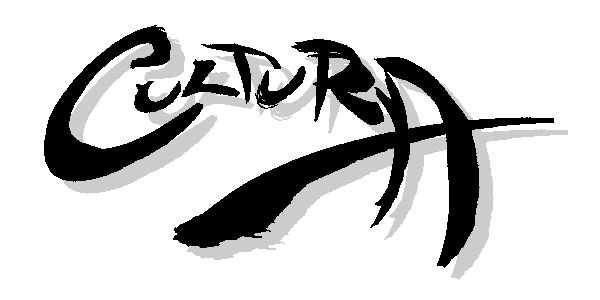

|
|
 |
 |
|
Abstract In our global world, in which multinationalcompanies constantly form or merge and in which people of diverse nationalities are increasingly asked to communicate and work together, the need to understand a culture other than one's own has become of paramount importance. We, as educators, must prepare our students for that new world and help them develop a deep understanding of these other cultures. This will no doubt be one of the most important skills graduates everywhere will need to possess in this new century. So now, more than ever, is the time to search for ways in which this new level of understanding of cultures around the world might be attained. One obvious place to start is in the language class, since we teach both language and culture. Yet, we rarely devote any time to the real task of developing our students' understanding of that other culture, and particularly of those aspects of culture that deal with attitudes and values. There is a good reason for this: these dimensions of culture are essentially abstract, elusive and difficult to access. What is needed is an approach and a tool. The CULTURA project presented below - designed and based at MIT and funded by the National Endowment for the Humanities - shows a concrete and dynamic way in which the Web can be used to foster understanding between American and French students. It offers learners (and teachers alike) on both sides of the Atlantic a unique comparative, cross-cultural approach for gradually constructing knowledge of other values, attitudes and beliefs, in an ever-enlarging construction of the foreign culture. Even though the focus is on the cross-understanding of French and American cultures, CULTURA provides a basic and broad methodology which can easily and effectively be applied to the cross-understanding of any two cultures, whether they are national cultures, business cultures and even sub-cultures. Introduction One common assumption in the field of foreign languages instruction is that when we teach language, we also automatically teach culture.We also commonly agree that the understanding of another culture is crucial and that if we are going to have meaningful social interactions, we need to know and understand the different cultural value systems that shape our respective thoughts and actions. Yet teaching culture in the classroom (in the sense of behaviors, attitudes and values) is a very difficult task, since culture is a very elusive, often abstract, implicit and essentially invisible notion. What is needed is an approach and a tool. One approach that seems to us full of promise is to start with the notion of cultural comparisons. As is well known, comparing and contrasting separate entities makes it possible to see differences and similarities that would not otherwise be visible. What CULTURA offers is a cross-cultural approach which has learners observe, compare and analyze similar materials from the two cultures studied. This approach allows them to start "seeing" the differences as well as similarities: the different values given to words, the negative or positive connotations, the various attitudes toward events or situations, etc.. It constitutes the first step toward deciphering and understanding what these differences may reveal and signify. The tool that best serves our purpose is the World-Wide Web. We believe that interactive multimedia/ hypermedia bring forward, juxtapose and connect different types of materials. The sheer process of juxtaposition allows the similarities and differences between these materials to actually emerge, thus providing students with the unprecedented ability to see and identify underlying connotations, traits and attitudes as well as discover, on their own, connections between different and separate elements. How CULTURA works Practically, the CULTURA project brings together two groups of students from two different countries who study in similar school settings (two high-schools, two universities, etc.). In the experiment described below, MIT students enrolled in a French language course worked in the Fall of 1997 with French students taking English at the Ecole Supérieure d'Aéronautique in Toulouse. Since the Fall of 1998, we have been working with French students and their teachers from the INT (Institut National des Télécommunications) in Evry. The work follows a gradual process that unfolds along a series of stages which introduce learners to progressively more complex artifacts and broaden the scope of their domains of inquiry.
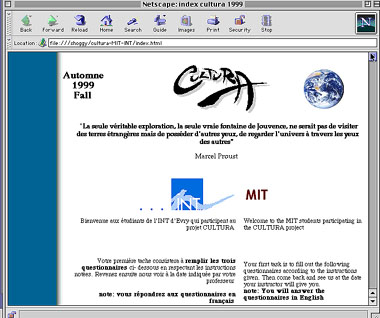
Stage 1: Questionnaires The interface chosen for the project is a bilingual display
of information, thus facilitating the comparison of cultural
elements. In the first stage, students start by answering, in
a spontaneous manner and in their own native language (so as
to allow all cultural nuances to be fully expressed) a series
of identical questionnaires, in French and in English.  These questionnaires have been designed by us to ascertain basic cultural differences toward such topics as interactions between people ( parents, neighbors, friends), between settings (public spaces, private spaces, work, etc.). The three types of questionnaires are:
The students fill out these questionnaires directly on the Web. You will find below an example of the Sentence Completion questionnaire from the Fall of 1999. Stage 2: Observations The responses to each question appear on the Web site side by side, allowing both sets of students to analyze - first individually then collectively in their respective classes - the various responses. This leads students to immediately discover:
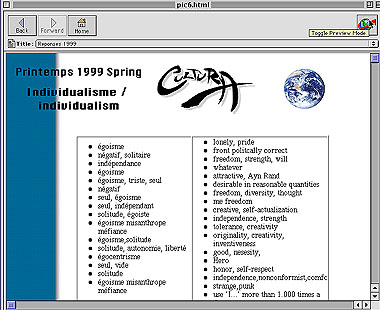 A quick observation allows students to discover that the word "individualism" is associated on the American side with very positive notions such as personal freedom, creativity and self-expression while on the French side the word often connotes notion of self-centeredness and solitude
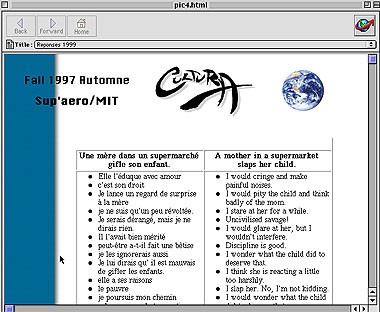 show that, beyond some similarity between the French and American responses, big differences emerge: American students are almost unanimous in their condemnation of the mother (some going as far as saying " I wonder if I should call the cops") whereas most French students tend to assume that the child did something wrong, that somehow he or she deserved to be slapped and that accordingly the mother was justified in slapping her child, prompting some student to go as far as saying "J'applaudis") Stage 3: Exchanges and Forums Taking their cues from a word, a sentence or a situation, the students then communicate their first reactions and observations to their transatlanctic counterparts in an open forum accessible to all participants (the teachers read and follow the forums but in no way intervene). This asynchromous communication (forums are posted and are not in real time) takes place in the students mother tongue and not in the target language so as to maintain the cultural and linguistic richness of the exchange. Students are encouraged to work in the following three directions:
Thus, in the forums that took place during the Spring of 1999, both groups of students wondered why the concept of individualism led to such contradictory notions. There ensued an opened discussion where the French students tried to explain to the Americans students why they have such a negative notion of individualism. 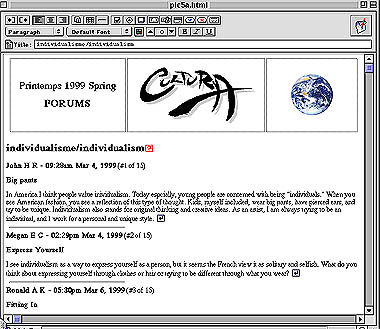 http://web.mit.edu/french/Cultura-website/archives/99/forums/wordassoc/individualism.html The forum relating to the mother slapping her child led to reactions of surprise and to questions relating to parental authority, to notions of discipline, to differences between the public and the private and even to child abuse, as shown in the exchange below:  Amerian students noted that in the answers tothe "school/ecole" questionnaires, French students never mentionned the word "fun" and wanted to know why. Stage 4: Broadening the fields of exploration and the analysis In this next stage, students are invited to analyze an ever increasing variety of documents relating to both cultures. These documents, which allow them to broaden the scope of their investigation, can be found directly on the Web (copyright permitting), or are seen or read in class. Examples of materials included are:
Both groups of students are encouraged to exchange their observations on the films and other materials. An internal search engine allows students to search across the Web site for a specific word and to find all instances of its use across all a new access to materials. Methodology The goal of this project is to develop and support a new methodology for learning about another culture - a methodology which is not based upon being "taught" what American or French cultures are like or which does not reduce culture to a series of facts about the other country. It is built upon an interactive process that involves interactions with multiple materials - raw or mediated - and multiple partners - learners, teachers, other students, other teachers and experts. This multiplicity of voices is meant to lead users, under the skillful guidance of a teacher, to gradually construct and refine their own understanding of the other culture, in a continuous and never-ending process. Students work both in and outside of class. Outside of class, students answer questionnaires, analyze the films, read articles, communicate with their partners. They are encouraged to simultaneously pursue discussions as far as they can on any of the topics touched upon in the questionnaires and to also expand their knowledge and understanding of the other culture by reading and analyzing various materials and texts. The classroom (where the language used is always the target language) becomes the place where ideas, findings, etc... are brought together, confronted and discussed. It is the place where students start developing, out of that mosaic of information and with the help of their own classmates, their own web of interpretations and an overall, global understanding of how the other culture works, what it is based on and why it functions the way it does. Since CULTURA is located in a language class, a lot of time is also devoted to the study of language. Both the answers to the questionnaires and the forums, by virtue of both being written in the writer's native language, provide the transatlantic partners with an extraordinarily rich source of authentic speech, which can become yet another focus of study, in its own right. Depending on their level of proficiency, students will study how, for instance, concepts which have no real word equivalent in one language are expressed in the other language. They will analyze and compare the different discourses: the ways in which ideas are expressed, the use of objective versus subjective statements, the use of abstract notions versus concrete examples; the amount of positive versus negative statements; the use of slang, etc.... This allows the study of vocabulary, semantics, grammatical structures and stylistics to be fully incorporated in the discussions.
|
|||||||||||||||
|
CULTURA was created at MIT in the Foreign Languages and Literatures Department in 1997 by Gilberte Furstenberg Shoggy Waryn, and Sabine Levet:
Gilberte Furstenberg was born and educated in France where she received her Agregation. She taught English at the University of Paris-Nanterre, then moved to the United States where she became a correspondent for the French news magazine L'Express. Her next career move brought her to M.I.T. where she has been teaching French for the last twenty years. In her courses, from the very beginning to the advanced levels, she makes use of authentic print and video materials in order to integrate culture into the language curriculum. She also favors a cross-cultural approach to the study of materials, as a way of accessing the different underlying values in French and American cultures. Her research interests lie in the development of interactive multimedia programs for learning French an developing an understanding of its culture. She is the principal author of A la Rencontre de Philippe, a pioneering interactive fiction, Dans un quartier de Paris, an interactive multimedia documentary. Both have won national and international awards and are published by Yale University Press. She is currently involved in the development of a Web-based cross-cultural project, entitled CULTURA, which provides a unique comparative approach for understanding another culture. She has given numerous presentations, lectures and workshops in the U.S. and abroad focusing on the many uses of multimedia in the foreign language curriculum, and thesubsequent emerging role of the foreign language teacher. She is the author of pedagogical guides, articles, and chapters in books. (for a complete list of publications)
After studying English literature in France and England, Shoggy came to the United States in 1985 to study film and communication studies at the University of Iowa. His Ph.D research "French Television, French Culture" bridges his interest in language, culture and media and was completed in 1997. Shoggy joined the French section at MIT in 1991 after several years of teaching at various levels both of French and Filmand has specialized in the introduction of multimedia in the curriculum of intermediate French. In 1995 and 1996, Shoggy received a grant from the Consortium for Language Teaching and Learning to develop ReelWords, a program that provides an interactive subtitling system for laser disks and Macintosh. He then started to work on CULTURA, both at the conceptual and the design level. Shoggy also worked at Smartplanet and WebCT before joining the French Studies Department at Brown Univeristy
Sabine graduated from La Sorbonne and has been teaching at MIT from 1989 until 2001. She currently teaches Beginner and Intermediate French at Brandeis University. Teaching interests: Language, culture, curriculum materials development, interactive technologies applied to teaching.Among her many publications, she has co-written the Student Activities Workbook for Dans un quartier de Paris. |
|||||||||||||||
|
CULTURA has received the financial support of the following institutions:
|
|||||||||||||||
|
Pour Cultura: Prof. Katherine Maillet, Dpt. de Langues et Humanités, Prof Susan Fries, Dpt. de langues et Humanités et Prof Kathryn English, Dpt. de Langues et Humanités
Pour CULTURA: Prof. Jean-Claude Jacques .
Marcelin Berthelot Créé en 1974, situé à deux pas
de la Cité des Sciences et de l'Industrie de Paris, le
lycée, qui porte le nom d'un chimiste et homme politique
français qui vécut de 1827 à 1907 à
Paris, accueille 600 élèves et 60 professeurs.
Il dispense un enseignement général, préparant
aux baccalauréats littéraire, scientifique, et
économique, et technologique, menant aux |
|||||||||||||||
|
|
|||||||||||||||
|
|
|||||||||||||||
® CULTURA 1999